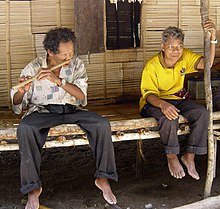โอรังอัซลี
โอรังอัซลี (มลายู: Orang Asli, แปลว่า คนกลุ่มแรก, คนพื้นเมืองดั้งเดิม) เป็นชนพื้นเมืองกลุ่มน้อยในประเทศมาเลเซีย และถือเป็นผู้อยู่อาศัยกลุ่มแรกสุดของมาเลเซียคาบสมุทร
 โอรังอัซลีในแถบที่สูงแคเมอรอนกำลังบรรเลงขลุ่ยจมูก | |
| ประชากรทั้งหมด | |
|---|---|
| 178,197 คน (2010)[1] | |
| ภูมิภาคที่มีประชากรอย่างมีนัยสำคัญ | |
| ภาษา | |
| กลุ่มภาษาอัซลี (ออสโตรเอเชียติก) กลุ่มภาษามลายูพื้นเมืองดั้งเดิม (ออสโตรนีเซียน) | |
| ศาสนา | |
| คติการนับถือผี, ศาสนาคริสต์, ศาสนาอิสลาม, ศาสนาบาไฮ | |
| กลุ่มชาติพันธุ์ที่เกี่ยวข้อง | |
| ชาวมลายูคาบสมุทร เซมัง, เซโนย และมลายูดั้งเดิมในมาเลเซียคาบสมุทร มานิในไทยภาคใต้ โอรังริมบา, ตาลังมามัก, อากิต, ซาไก (อินโดนีเซีย) ในสุมาตรา |
ข้อมูลจากปี 2010 มีประชากรของประเทศมาเลเซียเป็นโอรังอัซลีอยู่ที่ 0.6% หรือราว 180,000 คน โอรังอัซลีถือเป็นกลุ่มคนหนึ่งในบรรดากลุ่มชาติพันธุ์ของมาเลเซีย ซึ่งยังรวมถึงชาวมลายู, ชาวจีน, ชาวอินเดีย และโอรังอาซัลในซาบะฮ์และซาราวัก นอกจากนี้ โอรังอัซลียังมีสถานะพิเศษที่กฎหมายของมาเลเซียให้การรับรอง[2]
อ้างอิง
แก้- ↑ Colin Nicholas (20 August 2012). "A Brief Introduction: The Orang Asli Of Peninsular Malaysia". Center for Orang Asli Concerns. คลังข้อมูลเก่าเก็บจากแหล่งเดิมเมื่อ 2020-02-16. สืบค้นเมื่อ 14 June 2018.
- ↑ "Aboriginal Peoples Act 1954 (Revised 1974)". www.commonlii.org. สืบค้นเมื่อ 2021-12-13.
บรรณานุกรม
แก้- Benjamin, Geoffrey & Cynthia Chou, บ.ก. (2002), Tribal Communities in the Malay World: Historical, Social and Cultural Perspectives, Leiden: International Institute for Asian Studies (IIAS) / Singapore: Institute of Southeast Asian Studies (ISEAS), p. 490, ISBN 978-9-812-30167-3
- Benjamin, Geoffrey (1985). Karl L. Hutterer, A. Terry Rambo & George Lovelace (บ.ก.). In the long term: three themes in Malayan cultural ecology. Cultural Values and Human Ecology in Southeast Asia. Ann Arbor MI: Center for South and Southeast Asian Studies, University of Michigan. pp. 219–278. doi:10.13140/RG.2.1.3378.1285. ISBN 978-0-891-48040-2.
- Benjamin, Geoffrey (2013). Ooi Keat Gin (บ.ก.). Orang Asli. Southeast Asia: A Historical Encyclopedia from Angkor Wat to East Timor. Vol. 2. Santa Barbara CA: ABC-CLIO. pp. 997–1000. ISBN 978-1-576-07770-2.
- Benjamin, Geoffrey (2013). "Why have the Peninsular "Negritos" remained distinct?". Human Biology. 85 (1–3): 445–484. doi:10.3378/027.085.0321. hdl:10220/24020. ISSN 0018-7143. PMID 24297237. S2CID 9918641.
- Orang Asli Now: The Orang Asli in the Malaysian Political World, Roy Jumper (ISBN 0-7618-1441-8).
- Power and Politics: The Story of Malaysia's Orang Asli, Roy Jumper (ISBN 0-7618-0700-4).
- 1: Malaysia and the Original People, p. 21. Robert Dentan, Kirk Endicott, Alberto Gomes, M.B. Hooker. (ISBN 0-205-19817-1).
- Encyclopedia of Malaysia, Vol. 4: Early History, p. 46. Edited by Nik Hassan Shuhaimi Nik Abdul Rahman (ISBN 981-3018-42-9).
- Abdul Rashid, M. R. b. H., Jamal Jaafar, & Tan, C. B. (1973). Three studies on the Orang Asli in Ulu Perak. Pulau Pinang: Perpustakaan Universiti Sains Malaysia.
- Lim, Chan-Ing. (2010). "The Sociocultural Significance of Semaq Beri Food Classification." Unpublished Master Thesis. Kuala Lumpur: Universiti Malaya.
- Lim, Chan-Ing. (2011). "An Anthropologist in the Rainforest: Notes from a Semaq Beri Village" (雨林中的人类学家). Kuala Lumpur: Mentor publishing(ISBN 978-983-3941-88-9).
- Mirante, Edith (2014) "The Wind in the Bamboo: Journeys in Search of Asia's 'Negrito' Indigenous Peoples" Bangkok, Orchid Press.
- Pogadaev, V. "Aborigeni v Malayzii: Integratsiya ili Assimilyatsiya?" (Orang Asli in Malaysia: Integration or Assimilation?). - "Aziya i Afrika Segodnya" (Asia and Afrika Today). Moscow: Russian Academy of Science, N 2, 2008, p. 36-40. ISSN 0321-5075.
แหล่งข้อมูลอื่น
แก้- Malaysian Orang Asli Foundation เก็บถาวร 2013-07-28 ที่ เวย์แบ็กแมชชีน
- Peninsular Malaysia Orang Asli Graduates Association (PSOA)
- Department of Orang Asli Development/Jabatan Kemajuan Orang Asli - JAKOA
- Centre for Orang Asli Concerns (COAC) เก็บถาวร 2021-06-13 ที่ เวย์แบ็กแมชชีน
- Perak Orang Asli Foundation
- MOASF ( Orang Asli on Facebook )
- Orang Asli di Taman Negara
- Melawat Kediaman Orang Asli Di Asia Camp Taman Negara
วิกิมีเดียคอมมอนส์มีสื่อที่เกี่ยวข้องกับ โอรังอัซลี